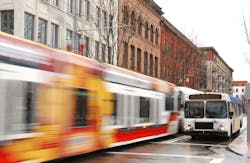What's Standing in the Way of Building Housing Near Transit Stops
Transit-oriented development has gained popularity among a growing number of interest groups and yet developers commonly face a series of hurdles when building apartments and other dense housing options near subway, rail, and bus rapid transit routes, a new study conducted by the Urban Institute finds.
From 2000 to 2019, American communities added almost nine times as many housing units distant from transit stations as they did near them. Lack of investment in public transportation over the past few decades, combined with the fact that even where substantial transit exists in a community, new housing is more likely to be built far from transit than near it, suggests local planning and zoning policies are also to blame, Route Fifty reports.
Analysis for the Urban Institute study was conducted by Yonah Freemark, principal research associate in the Institute's Metropolitan Housing and Communities Policy Center. He suggests state and local governments should go beyond simply changing zoning to allow transit-oriented development and should include land acquisition in their planning for new transit projects as well.
“There’s not much coordination between transit agencies and local governments when it comes to actually planning these projects,” he said. “This is a key opportunity for them. It does not require federal involvement. If these entities want to cooperate with their transit agencies, they can do so and then they can leverage the benefit of being near transit to create new publicly owned land that can be used for affordable—or any—housing development.”
